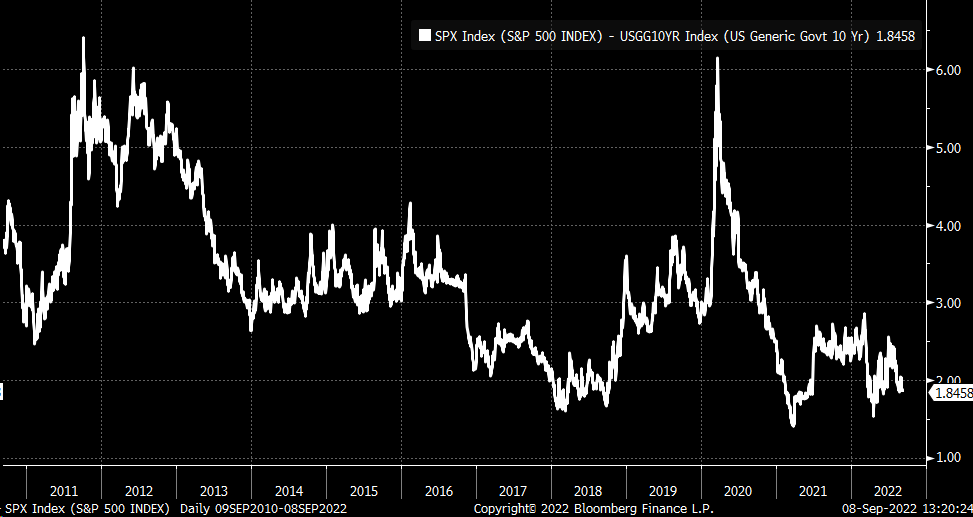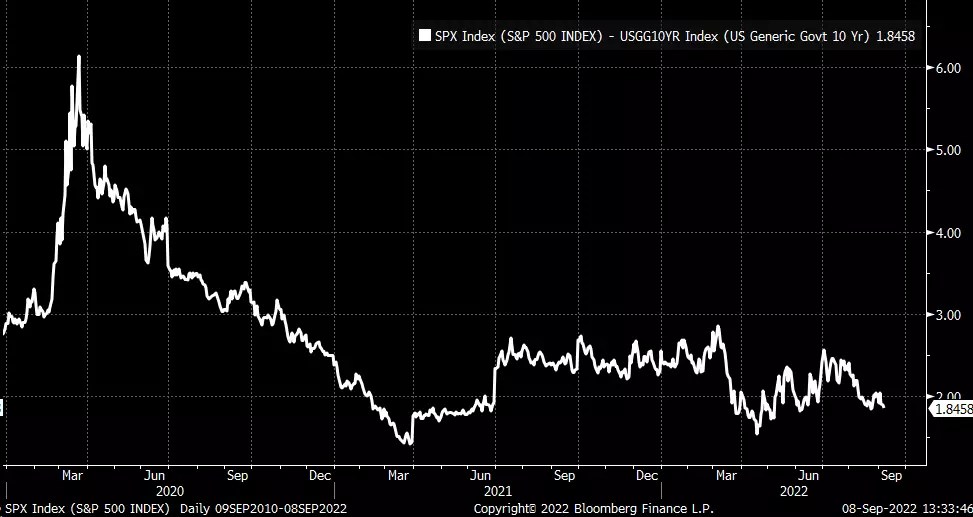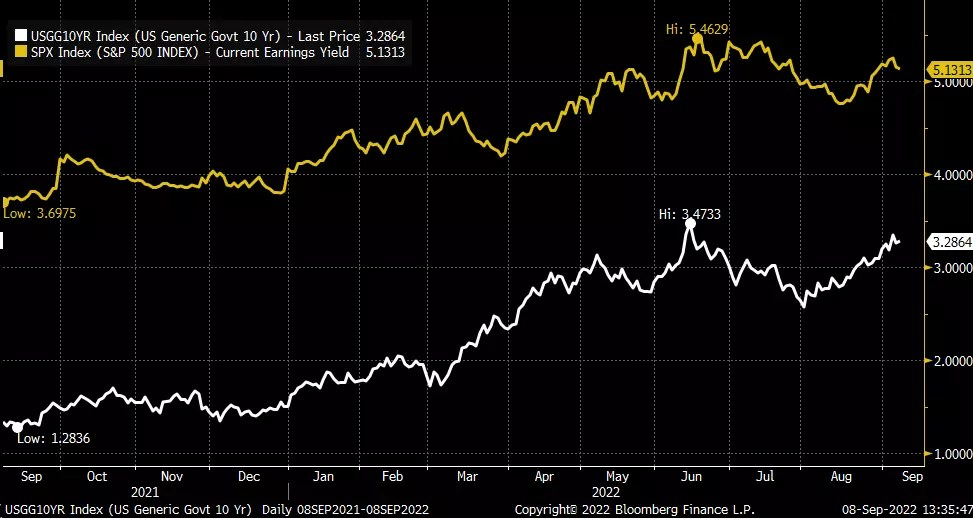Yields have risen sharply since the middle of August
Stock prices have fallen but not fast enough to account for the drop in bonds
This would indicate that stocks may still have further to fall
Yields have rocketed higher, and stocks have failed to keep pace with the surge. So despite the recent plunge in equity prices, indexes like the S&P 500 are more expensive today relative to bonds than before stock prices fell. It doesn’t make one feel good now, does it?
Looking at the spread between the S&P 500’s earnings yield over the trailing twelve months and the current 10-year Treasury rate shows that the spread has contracted. That spread is now around 1.84% and the significantly lower end of its historical range of the past ten years.
 S&P/10-Year Yield Spread
S&P/10-Year Yield Spread
Failing To Keep Pace
Even more shocking is that the index has fallen by more than 8% since Aug. 16, yet the spread between the earnings yield and the 10-year is lower. In August, that spread was at 1.93%, which tells us that stocks today are more overvalued relative to bonds due to the speed at which yields have increased.
On Aug.16, the 10-year rate was around 2.75%; now, it is trading around 3.3%, a massive move in a brief period. This would tell us that despite the sharp decline in the equity market, stocks haven’t fully priced in higher yields and that stocks still need to fall further to account for the move higher in rates.
 S&P/10-Year Yield Spread
S&P/10-Year Yield Spread
Another 9%?
How much lower should stocks fall, of course, becomes the next question. For that, we can turn and look at where the spreads were in June and July, and at that time, they were between 2.2% and 2.6%, and if we take the middle of 2.4%, stocks would need to reflect an earnings yield that is about 50 bps higher than today, assuming the 10-year rate is unchanged.
That would push the earnings yield on the S&P 500 from around 5.15% today to about 5.65%, pushing the PE ratio from 19.4 to 17.7. Assuming earnings over the last twelve months of $204.91 would knock the value of the S&P 500 to 3,626 from its current 3,975, or a drop of about 9%.
 S&P Earnings Yield
S&P Earnings Yield
Impacts
The stocks that could get hurt the most in such a decline would be those that have seen their valuations rise or fall due to rates thus far. That would be stocks in the growth sector and many technology stocks or stocks that continue to carry high valuations in general.
It seems easy to see that despite stocks falling since Jay Powell’s Jackson Hole speech, the Fed isn’t going to back off tightening monetary policy anytime soon. That should make stocks worth less versus bonds and not worth more. Given the enormous move in yields, one would expect stocks to reprice along with bonds, especially since the Fed has proven it will be more aggressive than the stock market had anticipated.
Disclaimer: Charts used with the permission of Bloomberg Finance LP. This report contains independent commentary to be used for informational and educational purposes only. Michael Kramer is a member and investment adviser representative with Mott Capital Management. Mr. Kramer is not affiliated with this company and does not serve on the board of any related company that issued this stock. All opinions and analyses presented by Michael Kramer in this analysis or market report are solely Michael Kramer’s views. Readers should not treat any opinion, viewpoint, or prediction expressed by Michael Kramer as a specific solicitation or recommendation to buy or sell a particular security or follow a particular strategy.
Michael Kramer’s analyses are based upon information and independent research that he considers reliable, but neither Michael Kramer nor Mott Capital Management guarantees its completeness or accuracy, and it should not be relied upon as such. Michael Kramer is not under any obligation to update or correct any information presented in his analyses. Mr. Kramer’s statements, guidance, and opinions are subject to change without notice. Past performance is not indicative of future results. Neither Michael Kramer nor Mott Capital Management guarantees any specific outcome or profit. You should be aware of the real risk of loss in following any strategy or investment commentary presented in this analysis. Strategies or investments discussed may fluctuate in price or value. Investments or strategies mentioned in this analysis may not be suitable for you. This material does not consider your particular investment objectives, financial situation, or needs and is not intended as a recommendation appropriate for you. You must make an independent decision regarding investments or strategies in this analysis. Upon request, the advisor will provide a list of all recommendations made during the past twelve months. Before acting on information in this analysis, you should consider whether it is suitable for your circumstances and strongly consider seeking advice from your own financial or investment adviser to determine the suitability of any investment.
Source: Investing.com



























